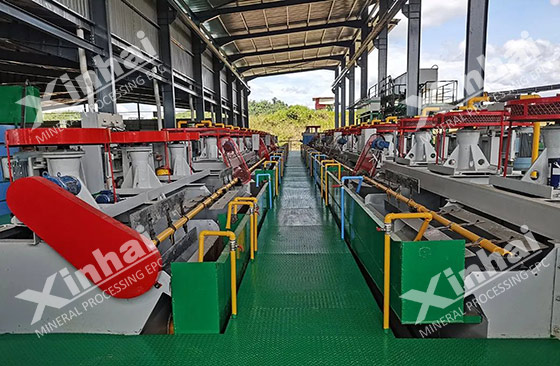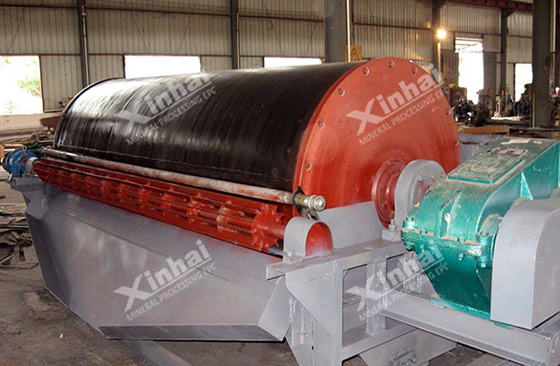Photovoltaic glass needs to use low-iron quartz sand with low iron content, high silicon purity and low impurity content. The following will take you to learn more about the beneficiation requirements of low-iron quartz sand for photovoltaics from three aspects: the quality control requirements of quartz sand, the process flow, and pickling agents.

The formation of quartz sand is accompanied by a large amount of impurity minerals, and it is impossible to directly find low-iron quartz sand that can meet the requirements of photovoltaic glass production without treatment. The quality requirements of photovoltaic glass for quartz sand are mainly reflected in three aspects: iron content, particle size, and refractory heavy minerals.
1. Iron content requirements
The obvious difference between quartz sand for photovoltaic glass and quartz sand for ordinary glass lies in the amount of iron. The iron oxides in the quartz sand will color the glass and reduce the light transmittance and transparency of the glass. Photovoltaic glass requires that the iron content of quartz sand should not exceed 1.50x10-4.
2. Granularity requirements
The particle size of the quartz sand affects the melting time as well as the quality of the photovoltaic glass. Too large or too small particles will affect the finished product. Quartz grit that is too large is difficult to melt and can cause grit to appear on glassware. Too small a particle size will result in too fast a melting rate. Premature formation of glass liquid also affects heat conduction, slowing down the overall speed instead. In addition, too fine quartz sand particles tend to be more viscous and tend to form agglomerates during the melting process, thereby affecting the melting speed.

3. Refractory heavy mineral requirements
Quartz sand contains some chromite and zircon. Chromite and zircon have high melting points and stable chemical properties. They cannot be eroded under high temperature conditions and are refractory heavy minerals. It is easy to form stones on photovoltaic glass, which will affect the later processing of finished products. Therefore, the total amount of refractory heavy minerals required for quartz sand for photovoltaic glass is ≤5ppm (calculated as Cr2O3), and the diameter of a single particle is ≤0.25mm.
The technological process of low-iron quartz sand for photovoltaic glass is divided into two parts: the raw material preparation stage and the pickling stage. The following is the specific process of quartz sand pickling.
1. The raw material preparation stage
(1)Quartz sand raw material crushing and grinding stage
Quartz sand raw ore needs to be crushed to 30~140 mesh by a crusher, and sent to a rod mill for scrubbing by a belt conveyor to realize the dissociation of quartz sand and impurity minerals, and then stored in the raw ore warehouse.
(2)Quartz sand graded dehydration stage
Quartz sand with qualified particle size is classified by vibrating screen and spiral classifier, and the quartz sand is sorted into different sizes according to requirements. After the magnetic separation stage, the quartz sand is passed through a magnetic separator to remove some iron impurities. Finally, the quartz sand is dehydrated through a high-frequency high-efficiency dehydration screen to obtain quartz sand concentrate.

2. Pickling stage of low-iron quartz sand
First, the pickling agent is adjusted in proportion to make pickling solution, and then the pickling solution is injected into the quartz sand reaction tank through the acid pump to carry out the pickling reaction. After the pickling reaction is completed, the pickling liquid is pumped out through the acid pump, and about 20% of the acid liquid remains in the deacidified quartz sand, and the residual acid liquid is pumped out by a vacuum pump. Then neutralize it with water and alkali to finally get the finished quartz sand after deacidification and washing.
In actual production, Xinhai Mining can provide environmentally friendly pickling compound agents. The pickling agent can be adjusted appropriately according to the specific molecular structure, density, content of impurity elements and other factors of quartz sand. If the iron content in the quartz sand is too high, iron remover can be added according to the actual situation. The effect of using Xinhai Mining’s environmentally friendly pickling compound agent is better than that of strong acid, and the impurity removal rate is higher. After pickling, the surface of the quartz sand after pickling is dust-free and has a better gloss.
The above are the main contents of the quality control requirements, process flow, and pickling agents of low-iron quartz sand for photovoltaics. With the continuous development of the low-carbon new energy industry, the demand for photovoltaic glass is also increasing, and the demand for the production capacity of low-iron quartz sand for photovoltaic glass is also increasing, and the beneficiation of low-iron quartz sand has gradually attracted the attention of the industry. Xinhai Mining recommends to conduct targeted tests according to the specific ore composition of quartz sand, and formulate a reasonable beneficiation process based on the test results, so as to achieve high-value utilization of ore.